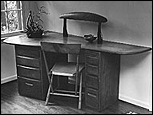THE OVERALL WORK
Furniture



With their heavy form and intricate surface carvings (above, left and center), Esherick's early pieces had a medieval feel reminiscent of the original Arts and Crafts furniture makers who reached back to the pre-industrial age for design inspiration. Esherick lived just a few miles from Rose Valley, Pennsylvania, a village established at the turn of the century as a utopian community of Arts and Crafts furniture makers. From the earliest days, his work was as sturdy as it was practical. Above, to the right, is one of more than four dozen chairs he made from oak ax handles in 1930 for Rose Valley's Hedgerow Theater. In 1998 -- 68 years later -- the chairs were still in use by theater patrons.



In the 1930s Esherick's work evolved an elegant simplicity combining the flow of modern sculpture with the function of furniture to create a new genre that became known as "free-form" furniture. His pieces inevitably invited viewers to touch and stroke their sleek curved surfaces. Today it may be difficult for a younger generation to appreciate Esherick's artistic impact because the style and concepts he pioneered echo throughout so much of the furniture and structural forms that now surround us.
© 1996 - 2004
HoagL@earthlink.net